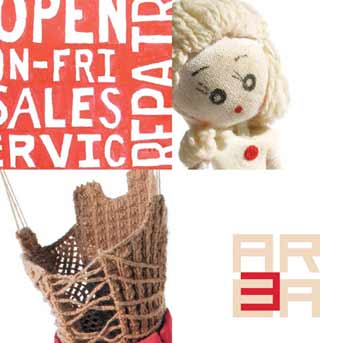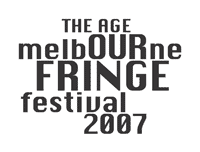| |
Emma Frederick, Tom Schofield & Tina Huang
"Area 3" (Melbourne Fringe Festival)
September 28 - October 26, 2007
Opening Friday 28 September 6-9pm
Area 3 at Off the Kerb, showcases three young Melbourne designers who
decided to take a different approach with their traditional design methodology and branch out into the contemporary visual arts. Emma Frederick focuses on a feminine domestic world of collected trinkets and decoration, Tom Schofield's work is centred on the masculine world of rules, orders and calculated information of typographic signage, and Tina Huang's androgynous pieces concentrate on the blurring of these traditional gender expectations and
gender specific prototypes.
Frederick, a mad collector of disregarded and unvalued "kitsch" objects,
designs a whole living room, complete with wall paper, curtains, rugs and
furniture to compliment a collection of objects including small owl
figurines and pineapple food bowls. The affect is to lull the viewer into
a feeling of safety, one that many associate with the home, to question
the worth of the everyday objects with which we surround ourselves. Like
the clothing and hairstyles that we wear everyday, this unconscious
interior design process, takes place in our everyday homes, reflects our
identities, personalities and tastes in a much more important way than
first thought of. Instead of being looked down upon as tasteless pop
culture that claims to be artistic yet fails only to become cheap and
sentimental, Kitsch objects have had a revival in the last few years,
rebelling in its own over the top extravagant designs and decorations.
Clement Greenberg pronounced, "kitsch is the epitome of all that is
spurious in the life of our time." However Frederick masters her room of
kitsch designed furniture and odd ornaments into something extremely
genuine and authentic in its representation of not only the artist herself
but of a society that is a little obsessed with all things kooky.
Schofield's objects are a visual response to na´ve hand produced signage that we see
in everyday life. He explores how this typographic signage by hand
(compared to the controlled computer generated fonts) is a direct
reflection on those who have created them. However na´ve these signs are,
there is always a conscious design process used, even by those who are not experts in design. The images are inspired by Jean Michael Basquiat who tried to capture a raw non-pretentious energy that comes from hand written signs or graffiti, doing so with interesting subject matter taken from the everyday world. The non-computer generated typography is
honest in its character and can even reflect a person's ethnicity, tastes,
attitudes and intentions. The result is an earnest and vulnerable
expression that describes the creator and leaves a lasting impression in
the mind of the viewer.
Tina Huang in her installation and performance explore notions of
sexuality, subculture and fetish indulgence in men's corsets. Exploring
Roland Barthes notions on fashion and dress, she focuses on men who opt
to dress in a more feminine way. The corset, traditionally seen as a
symbol of women's oppression, is a highly provocative and sexualised
object that contorts and manipulates the body into something considered
more desirable. Huang researched how the corset was used by the dandy men
of the 1920s in London and Paris and found that it indeed was used in the
same way: to create a wasp waist in order to exaggerate a manly chest.
This show focuses on shifting the boundaries between feminine and
masculine distinctions and stereotypes, and how fashion can make one's
persona change completely to become extremely androgynous.
|


back to Previous Exhibitions & Launches
|





